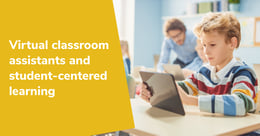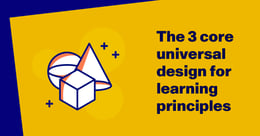
Game-based learning activities by grade level
You wouldn’t hand a kindergartener a trigonometry textbook and then quiz them on what they learned half an hour later, right?
It’s a bit of a silly example, but it illustrates an important concept: We use the term “K-12” to describe one subset of education, but there’s a whole universe of different student needs within that category that we have to address.
This principle applies to traditional learning methodologies and game-based learning alike. Read on to learn more about game-based learning activities for students in different grade levels.
Why are teachers interested in trying out game-based learning activities?
Game-based learning activities provide educators with a fun and entertaining way to help students tap into learning.
When the pandemic forced schools to adopt distance learning policies, many teachers found themselves looking for new ways to drive engagement with course materials during a time of discomfort and disruption.
Writing in Edutopia, instructional technologist Kendra Cameron-Jarvis described how to use gamification to support social studies curricula during hybrid learning. She suggested combining game elements with free resources like interactive treks on Google Maps and an original narrative quest presented on Google Slides. Sounds great, right? In fact, this kind of discovery would probably be useful in other learning environments too.
[READ: “3 ways game elements can drive educational engagement (Infographic)”]
How can teachers follow best practices to implement game-based learning activities?
Students can still benefit from game-based learning activities in today’s educational landscape, and a key attribute of effective implementation involves tailoring your approach to your students while pursuing clear and achievable learning outcomes.
That means meeting your learners right where they are—not with digital games that seem beneath them or too difficult for them to even know where to start.
Emphasize diverse perspectives and ensure student representation
As with any other learning experience, game-based activities should be reflective of, and accessible to, a diverse array of learners.
In a report on leveraging game mechanics in a middle school STEM learning activity, the authors note that despite shortages of STEM professionals, young learners from Hispanic backgrounds are too often effectively excluded from the field. In particular, the middle grades prove to be a pivotal juncture. This may be due to several factors, including a lack of culturally relevant educational experiences and limited access to real-world, visible role models.
Interesting gameplay—delivered in a culturally relevant context reflective of diverse player experiences—can help rectify such discrepancies by sending a clear message: This field is for you, it’s part of your world, and you can try it out right now.
Keep reading to learn more about how game-based learning works for different grade levels.
Gaming in schools: Student considerations by grade level
There’s no shortage of activities that can be used to help inspire students throughout their K-12 journeys. Here, we’ll focus on game-based learning examples for students in elementary school through high school.
Elementary school: Teach key skills early
What’s the right age for students to start using educational video games in the classroom? Truthfully, video games are already a part of many students’ daily lives from quite an early age.
Foster open-ended exploration to build foundational skills
In a blog post about introducing Minecraft Education to a second grade classroom, the author described some initial hesitancy about bringing this platform to such young learners. After trialing the game with an after-school club, however, anticipation built, and the rest of the second graders were eager for their turn.
One unexpected bonus of this early introduction was that it provided students with a vital arena for cultivating digital citizenship and practicing how to use devices that don’t have touch screens—important 21st-century skills and foundational competencies for game-based learning.
[READ: “Game-based learning in education: A quick history”]
Leverage a teaching strategy that elevates achievement and attitude
Minecraft Education implementations can allow for deliberate curriculum connections too, and there’s good news about the potential for students to achieve defined learning outcomes through other game-based learning activities. As an added benefit, learner engagement could get a boost as well.
According to a paper that examined the effects of game-based learning in an elementary math setting, students who were part of the study were able to cultivate a growth mindset. In the concept that was being covered, student achievement improved, as did attitudes toward math. These findings point toward better student engagement—and outcomes—for learning processes grounded in game-based learning.
[READ: “Boosting long-term student success with independent practice in math”]
Middle grades: Reinforce persistence and focus on motivation
Students in the middle grades are looking for something different from game-based learning activities. At this stage, it’s particularly important that digital game-based learning experiences meet them where they are by providing appropriately sophisticated storylines, worlds, and learning environments without serving up challenges that are too frustrating. Getting the game design right can be difficult, but it’s definitely worth the effort.
Support academic perseverance
For learners who struggled in elementary school—and many have throughout the pandemic—learning gaps that persist into the middle grades can wreak real havoc. This may be particularly true when the subject matter requires students to make linear progress, such as in math. When foundational concepts are missing from student learning, it can feel all but impossible to take in new information.
An Edutopia interview with two educational game creators explored how engaging games allow students to practice key concepts in a way that’s judgment-free and facilitates active learning through immediate feedback and trial and error.
Find out what motivates students in the middle grades
What makes junior high students tick? In research from Iowa State University on motivation and game-based learning from middle school to higher education, teachers from around the world were surveyed. The study found that middle school educators tended to rely on a unique assortment of game mechanics, including “challenge, feedback, and competition.”
Additionally, the study’s authors observed, “At the middle school level, the students will engage quickly with a creative narrative and are not focused on academic achievement or class ranking.”
As an aside, teachers will also want to heed a clear message from some of their peers who were quoted in the survey findings: Game-based learning activities can take a lot of time to set up and execute. And though it may not be the most desired mode of learning for every student, it can help reengage those who may not feel initially connected to other modalities.
High school: Provide deep engagement and real-world relevancy
In the later grades, game-based learning activities have a lot of heavy lifting to do. As high school students turn their attention toward career opportunities, college admissions requirements, and more, they’ll be looking for a more sophisticated experience from learning games.
Even though these students may have a more pragmatic approach to their education, game-based learning activities don’t necessarily have to take a back seat. On the contrary, they still have a strong role to play in fostering critical thinking and helping students achieve learning objectives.
Immerse students in vibrant literary experiences
Game-based learning can prove useful for ELA courses throughout a student’s K-12 educational experience, but let’s zero in on what it can offer for high school students.
What about encouraging students to create their own games, for example? An Edutopia article explores how students can practice literary analysis by designing games. Teachers could customize the assignment to focus on summarization, setting, plot, and more. Students could write code, assemble slide decks, or even create board games to fulfill the project’s requirements.
High school English teachers can also stay on the lookout for rich, immersive video game adaptations of staple texts in their curricula. For instance, a game modeled on Henry David Thoreau’s “Walden” can be used to help learners engage more deeply and meaningfully with the text and its associated themes.
Help high school students build valuable life skills
As students prepare to become lifelong learners, they know that the world beyond K-12 will present new challenges. Game-based learning activities can help students build new skills and learn about important topics as they prepare for life after school.
Take financial literacy games, for instance. Learners can get their heads around how to set a budget, manage money, balance student loans, empathize with different financial circumstances, and more.
Game-based learning activities: Not a passing fad
Game-based learning activities have widespread appeal, from the youngest of learners to those in the upper reaches of high school and beyond. Students in elementary school can benefit from engaging opportunities to practice digital citizenship, develop a growth mindset, and hone foundational subject-specific skills. As students progress through their educational careers, playing educational games—and designing their own—can help them forge stronger connections with important concepts in STEM, literature, the social sciences, and more. When educators have the opportunity to support students with high-quality games, the rewards speak for themselves.
Looking for more information about how to use game-based learning activities to achieve specific learning goals in the K-12 classroom while driving student engagement? Check out our K-12 guide to game-based learning.




![3 ways game elements can drive educational engagement [Infographic]](https://paper.co/hs-fs/hubfs/Paper-Blog_3-ways-game-elements-can-drive-educational-engagement.jpg?width=260&height=136&name=Paper-Blog_3-ways-game-elements-can-drive-educational-engagement.jpg)

